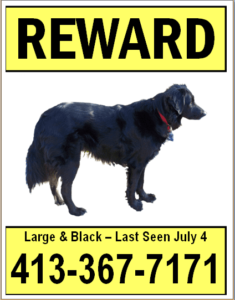If you can’t find your dog – some steps to take
Look around
- Look around your house and yard – if you’re not sure if your dog got out of your property, double-check – they might just be hiding some place, like under a bed, behind a couch, etc. This might be especially true if they’re hiding from something that scared them, like fireworks, thunder, smoke alarms, etc.
- Look around your immediate neighbors’ yards. Call your dog’s name, shake plastic bags or jugs with dog food/treats inside (if your dog knows that sound), squeak toy, and jingle car keys (if your dog likes going for a ride in the car).
- Follow the path you normally walk if you take a regular route, and/or go to your dog’s favorite places – the area with lots of squirrel trees, the park you visit, or the friends’ house you go to.
- If possible, keep one person at home, in case the dog returns, or a neighbor brings your dog by. If that’s not possible, leave a sign “Have you found my dog?” with your phone number at your door.
Tell others
- Provide a good description of your pet: breed(s), hair/coat length and color, special markings, size, age, ears (pointed, long, cropped, droopy) and tail (cropped, curled, etc.). You might want to reserve some special feature of your dog as a “secret” to make sure that you are not scammed (see below) – for example if your dog has one white “sock” you can ask anyone who contacts you to describe the dog’s feet.
- Tell your neighbors, especially people walking dogs. If your dog is attracted to other dogs, they might see your dog soon.
- Tell your local shelter. In San Jose, that would be San Jose Animal Care Center at 2750 Monterey Rd, San Jose. Also contact:
- Humane Society Silicon Valley at 901 Ames Ave, Milpitas
- Silicon Valley Animal Control Authority (SVACA) at 3370 Thomas Rd, Santa Clara
- County of Santa Clara Animal Services Center at 12425 Monterey Road, San Martin (Morgan Hill,San Martin, Gilroy and the unincorporated areas of Santa Clara County)
- Tri-City Animal Shelter (Fremont, Newark, Union City, San Leandro)
- Pets in Need Animal Shelter (Palo Alto, Los Altos, Los Altos Hills)
- Peninsula Humane Society (East Palo Alto, San Mateo County)
- Start putting up posters. The posters should say REWARD – LOST DOG at the top, then have a clear photo of your dog, and the best way to contact you urgently. You can include other important information like where and when the dog was last seen, and also information like “needs medication”, “fearful, do not approach” or “beloved family pet”, but “Reward – lost dog” and your contact info should be the biggest, boldest thing there. Make a bunch of black-and-white copies, and then glue those onto neon-colored posterboard to post in major intersections around your home.
- Put these posters at dog parks, pet stores, and walking or hiking trails
- Tell nearby vets, even ones you don’t use. If your dog is found, someone might take them to the vet to get scanned for a microchip.
- Tell nearby pet stores, groomers, and daycares.
- If your dog is microchipped, call the chip company and tell them. Make sure they have your best contact number on file.
- For each day that goes by, expand the circle of people you tell – further shelters, further vets, dog parks, grooming facilities, pet stores; and further intersections for your posters. Recruit some friends who can help you scan the “found dog” sections of various shelters and social media sites, can call vets, groomers, and more, and can put up posters in your expanding area.
Post on social media
- Create a post that says “REWARD – LOST DOG” with a photo and a good description and a way to contact you. Include the location where the dog was last seen. Make sure the post is public, and ask people to please share it. You can include other important information like “needs medication”, “fearful, do not approach” or “beloved family pet”.
- Post to as many platforms as you can – Facebook, Instagram, Twitter, NextDoor etc. Include #lostdog #reward and #dogsof[your city]. Look for specialized groups within each platform (like “lost and found pets [your city]”) and post there, too.
- Post to Pawboost.com and PetAmberAlert.
- Search for your dog on these sites, too. Note that many people will write “lost dog” when they mean they found a dog who is lost (instead of saying “found dog”), so look at other “lost dog” posts.
Watch out for scammers
- If someone says they’ve found your dog, ask them to text you a photo.
- You might want to reserve some special feature of your dog as a “secret” to make sure that you are not scammed – for example if your dog has one white “sock” you can ask anyone who contacts you to describe the dog’s feet. If they can’t describe this feature, don’t correct them (don’t tell them what your dog is actually like), just tell them it’s not your dog.
- Beware of scammers claiming to work with a legitimate pet-finding service such as Pawboost or individual pet-finders.
- Do not share your email address, social security number or license information. DO NOT send payment nor respond to any email sent.
- Meet anyone who claims to have your dog in a public place.
- More info on scams and common types.
More advice from HSUS, AKC, and Wikihow. Also check pawboost.com, The Center for Lost Pets, Home Again – National Pet Recovery Database, Pet Amber Alert, 24 Pet Watch, The Missing Pet Network, Hugs for Homeless Animals, and lostmydoggie.com
Prevention
If you’re reading this page, your dog is probably already missing. But to prevent losing your dog:
- Check your fences, gates and doors, especially after wind or rain storm. Do not rely on “invisible” fences to keep your dog contained – the joy of chasing a squirrel or meeting another dog, or the fear of escaping a coyote or aggressive dog or mean human, might overcome the discomfort of the shock (or vibration or tickle or stimulation or however electric shock was described in the collar/”invisible fence” marketing!).
- Train your dog to wait at the door as you go through
- Consider having an “airlock system” of double doors, such as a baby gate just inside your front door, or a fence just outside of it, so that thoughtless family members have backup, or a barrier attached to your door to hold your dog back during deliveries
- Make sure your dog is wearing ID – a collar with tags or an embroidered phone number, ideally at all times. Check that it is your accurate, current phone number
- Get your dog microchipped, so that this can be scanned if your lost dog is brought to a vet or shelter. Check that the chip company has your accurate, current phone number. Have your vet scan for the chip at your yearly checkup to make sure it’s still findable and readable.
- Consider a tracking collar that uses GPS to locate your dog. Most of these require a subscription service and may need to connect to a phone signal.
All material copyright Stacy Braslau-Schneck.
Would you, your training company, or your club like to reprint this? Please be sure to keep my name, business name, and the website URL with the article, and if possible, please send me a copy. See the Contact Page for email and mailing address.

